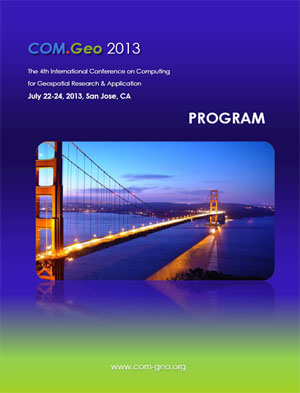Message from Conference General Chair
 It is our great
pleasure to welcome you to the 4th International Conference on
Computing for Geospatial Research and Application; in short form,
COM.Geo 2013, which takes place in the capital of Silicon Valley,
San Jose, California, U.S.A. on July 22-24, 2013.
It is our great
pleasure to welcome you to the 4th International Conference on
Computing for Geospatial Research and Application; in short form,
COM.Geo 2013, which takes place in the capital of Silicon Valley,
San Jose, California, U.S.A. on July 22-24, 2013.
The explosion of the power and sophistication of computing
applications in the past few years has revolutionized the way we
live and work. This marked trend is of especial significance for
geospatial computing, which directly relates to the very foundations
of our society and essentially embraces all the diversification of
its activities. Geospatial information, already important in many
scientific and engineering disciplines, is increasingly becoming an
integral component in consumer-driven technologies. How to further
improve or enhance geospatial information processing, organizing,
analysis, and visualization? Especially, handling rising flood of
digital data from many difference sources puts serious technical and
scientific challenges.
With rapid progress of information processing and multiple
disciplines, there are more and more promising computing
technologies, which could be employed to solve these problems. At
present, cloud computing, mobile computing, visual computing/GPU
computing, business intelligence, Internet of Things (IoT), and
social computing have been playing key roles in geospatial
applications. Some latest computing advancements, such as big data
computing, heterogeneous computing, IoT/sensor computing, and
bio-computing, have great potentials for the effective realization
of information processing in the geospatial environment.
The COM.Geo conference not only focuses on the latest computing
technologies for multidisciplinary research and development that
enables the exploration in geospatial areas, but also highlights the
impacts of these current and prospective computing technologies on
the future of the geo-world. Our consideration is intended to bring
fresh thoughts to explore new directions for geospatial research and
development. The conference also provides a vision and a combined
outlook for both computer and geospatial communities, i.e., how
computing technology is changing the landscape of geospatial
applications and how diverse geospatial information processing
requires the change of various computing technologies. COM.Geo is
playing a guiding role to advancing the technologies in computing
for geospatial fields.
COM.Geo conference is a leading-edge conference on computer science
and technology for geospatial research and application. It is also
an exclusive event that builds a bridge between computing and
geospatial fields. It connects researchers, developers, scientists,
and application users from academia, government, and industry in all
related fields. The previous COM.Geo conferences keynotes were
delivered from White House Office/USGS, DOD, DOT, DHS, U.S. FCC,
Microsoft, Oracle, Nokia, OGC, MIT, etc. The attendees were from
more than 50 countries all over the world. COM.Geo publications,
read and cited worldwide, have broad impact on the development of
theory, method and practice in geospatial computing.
Innovative geospatial research and application technologies are the
brightest spotlights at COM.Geo conference. COM.Geo 2013 has
exciting and high quality technical program sessions including
brainstorm plenary keynotes, leading-edge panels, emerging tech
shows, workshops, full papers, short papers, briefing papers, tech
talks, demo talks, posters, hot short talks, and exhibits for the
conference. Furthermore, at the conference, Google, Microsoft, NASA, IFTF,
MIT, Stanford University, and OGC reveal their latest cool
technologies and give the key insights about Google Fusion Table, Microsoft GeoFlow for
upcoming Excel 2013, energy efficient GPS sensing with cloud
offloading for location-based services, Big Data analytics,
worldwide geospatial data collaboration, innovative mobile city
exploration, augmented reality, Location-based access control for
geospatial data, etc. This year, the subfield program is also
explored on computer vision and image processing with geospatial
techniques. This strong combination is largely due to the technology
improvements in both domains and strong commercial application
incentives.
Special thanks to Keynote and Plenary Speakers, Dr. Carl Reed, Dr.
Jie Liu, Mr. Mike Liebhold, Mr. Curtis Wong, Dr. Jayant Madhavan, Dr. Kristian Kloeckl,
Mr. Patrick Hogan, and Dr. Kevin Montgomery, for their insightful
vision to be delivered to our attendees. We appreciate the
generosity of sponsors and partners: Computing for Geospatial
Research Institute, NASA, Google, Microsoft, Microsoft Research, OGC, George
Washington University, Stanford University, MIT, and IEEE & CPS. We
also would like to acknowledge the invaluable efforts and
contributions of COM.Geo team and student volunteers.
We look forward to an exciting week of sharing technical ideas and
visions with colleagues from around the world. We thank you for
attending the conference and being a part of this very important
event.
Lindi Liao, Ph.D.
COM.Geo 2013 General Chair